
© Herbert Migdoll. (Click image for larger version)
The Joffrey Ballet
American Legends: Interplay, Sea Shadow, Son Of Chamber Symphony, Nine Sinatra Songs
Chicago, Auditorium Theater
13 February 2013
joffrey.org
auditoriumtheatre.org
When you think of American legends, what comes to mind? George Washington? Johnny Appleseed? Twyla Tharp? Yes, if you’re going to The Joffrey Ballet’s winter season, which features work by such home-grown dance pioneers as Tharp, Jerome Robbins and Gerald Arpino, and Australian transplant Stanton Welch, all of whose choreographic forays with American music transcend traditional ballet idioms.
Musical pairings of Robbins with Morton Gould, Welch with John Adams (the composer!), and Tharp with Frank Sinatra exemplify America’s evolving cultural mythology and the intriguing tango of classicism and popular forms that has been slowly infusing the concert dance stage and spilling out onto Broadway and beyond for the past half-century or so.

© Herbert Migdoll. (Click image for larger version)
Robbins’ sunny, all-American Interplay (1945) fuses swing dance, cartwheels, athletic running and jitterbug with fouettes and double tours to remind us of the abounding energy and innocence of America on the brink of opportunity. Anything is possible for Ricardo Santos, who takes the stage with irresistible joy, spontaneity and spot-on technical brilliance. The clean lines of the ensemble’s primary-color t-shirts and practice tunics tell us it’s all about the movement. The non-linear story of youthful America plays out in short scenes where women flirt, men show off and couples court, giving the Joffrey ensemble ample opportunity to dazzle with joie de vivre and a nonchalance that belies the technical difficulty of the choreography.
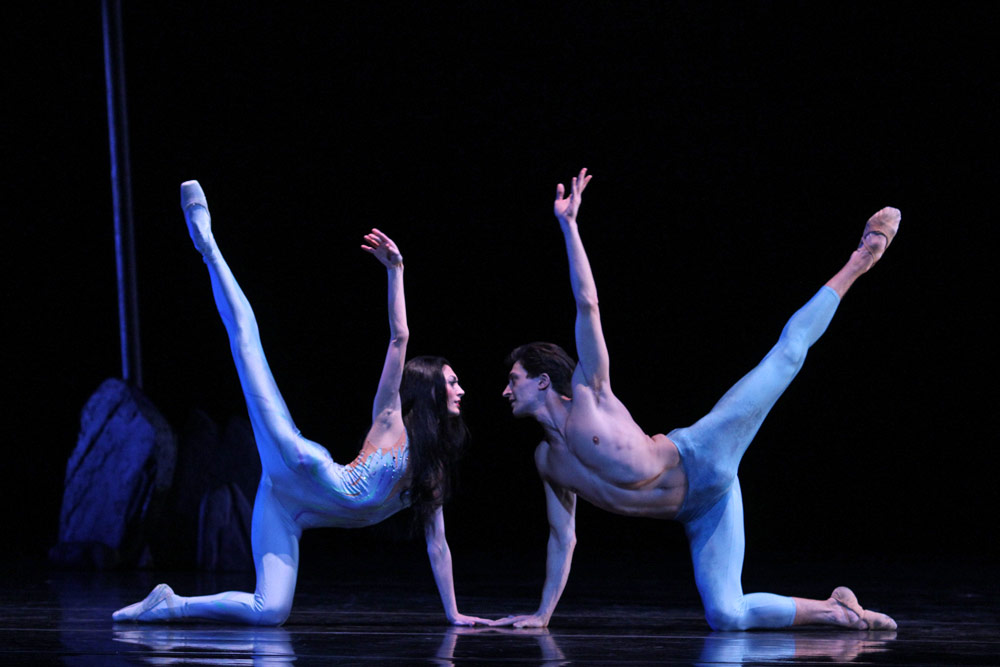
© Herbert Migdoll. (Click image for larger version)
Sea Shadow (1961) honors Gerald Arpino, co-founder of The Joffrey Ballet, who would have turned 90 this year. Set to the music of Maurice Ravel and hauntingly performed by Jeraldine Mendoza and Dylan Gutierrez, this story of a mortal falling in love with a sea nymph takes place at the interface of sea and land, dream and reality. At once sensual and other worldly, it opens with Gutierrez awakening, whether into his dream or from it we are not sure, in a superbly fluid progression of floor work, each segment of spine and limbs coming alive in sequence, his exceedingly long torso and legs eventually unfolding as his dream materializes from the sea to embrace him. Here we see a wonderful example of Arpino’s bold fusion of American modern dance forms that clearly borrows from the technique of Martha Graham, a daring statement that distinguished the Joffrey early on in its history. Torso undulations and floating limbs create a magical watery image of the dreamer and the dream merging with each other and with the sea. The contrast of Gutierrez’s languid movement and physical stature with the tiny, articulate Mendoza adds to the mystical quality of the duet, which culminates in Mendoza literally swimming away with him.

© Herbert Migdoll. (Click image for larger version)
A giant geometric grid stands out against a lit cyclorama to frame Stanton Welch’s Son Of Chamber Symphony (2012) and sets the tone for the spatial and tonal patterns of both music and movement. Flexed wrists and ankles punctuate a rainbow of musical color and texture coming from the orchestra, whose live performance collaboration with the dancers on stage provided an especially delectable treat. There was almost a “Star Wars” chic in the opening scene with dynamic Amber Neumann in a new-age tutu reminiscent of a vinyl disc, and Matthew Adamczyk in a unitard with cut-out windows. The central couple operates in counterpoint to a peripheral quartet of men, the movement contrasts ranging in extremes of tempo and texture. Neumann, whose strength as an actress complements the dramatic richness of her movement, played the emotionally-charged ballerina with just the right note of parody, blowing kisses one minute, and fluttering a frantic frappé of her toe shoe the next, evoking the quivering anxiety of a Swan Queen. Rhythmic shifts and key signature changes in the music, reminiscent of Bernstein, characterized the first movement and lent a spirit of adventure to the stage, with ever- contrasting spatial patterns and swiftly-changing movement qualities.
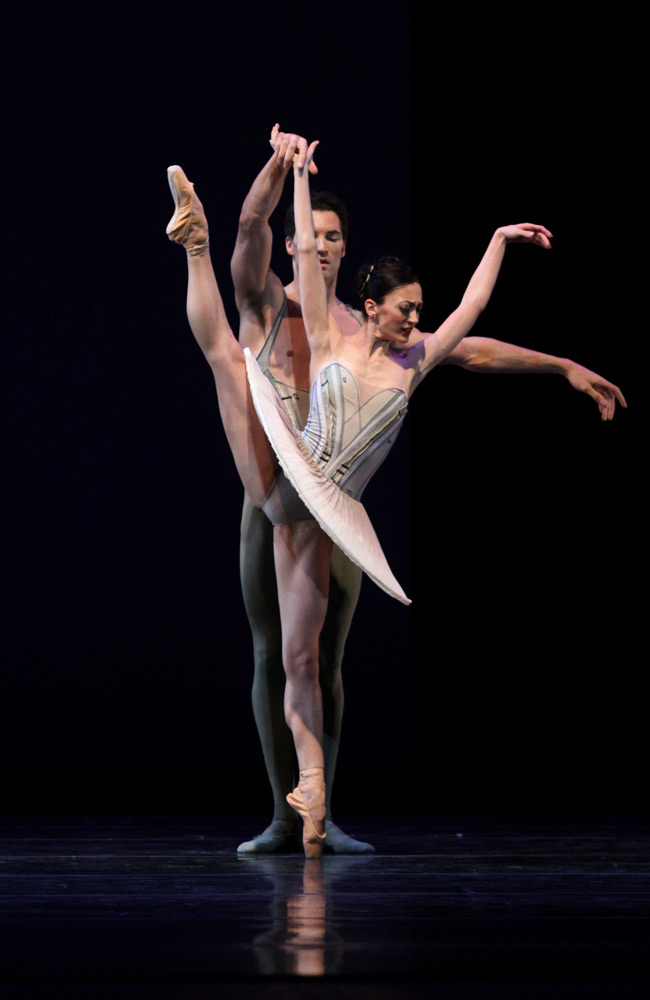
© Herbert Migdoll. (Click image for larger version)
The second movement is a sumptuous duet, performed by Victoria Jaiani and Fabrice Calmels, an on-stage pair made in heaven. The two melt into each other in an exquisite partnership so intuitive, so deeply attentive to each other’s every impulse and center of gravity that it takes Calmels only a hand on Jaiani’s shoulder to guide her promenade en pointe. It’s fun to watch Jaiani’s flexible disk tutu taking on a movement geometry all its own as Calmels folds his pliant partner around himself, dancers and costumes completing the sculptural design of the choreography. Welch makes optimum use of Jaiani’s unique attributes, her incredibly flexible spine and astounding technical strength, but what makes her performance so breathtakingly beautiful is the lyrical attenuation of emotion through extensions that seem to go on forever, from the center of her body out to the very tips of fingers and toes and beyond. Evoking the dying swan in a final montage, only a dancer with both supreme technical virtuosity and rich artistic sensibilities can create the kind of poetic translation of movement and music Jaiani embodies.
In the third movement, killer technical demands for the ensemble range from fouetté turns to échappés, a frappé motif, and spinning sequences in quick succession, the dynamics of molasses and prickly pears charging the movement with tactile immediacy. April Daly is a radiant presence as a daunting mistress of ceremonies. With Daly and partner Temur Suluashvilli holding the spotlight center stage, her penché en pointe was almost a show-stopper but for the ever-pulsating female corps, Swans from the Planet X, surrounding them.

© Herbert Migdoll. (Click image for larger version)
While Twyla Tharp has a long history with The Joffrey Ballet, the company performs her Nine Sinatra Songs (1982) for the first time this season. At opening night, some of the couples and individual dancers had not yet fully found themselves in the movement and music. Men in tuxes and patent leather oxfords, women in cocktail dresses and heels, they carry off the nightclub style with entertaining sparkle that remains, for the most part surface performance, but this viewer has every expectation that, with repeated performances, these superb dancers will find their way into the deeper layers of Tharp’s pathos and humor and her inspired physical rendering of Sinatra’s signature voice in American culture.








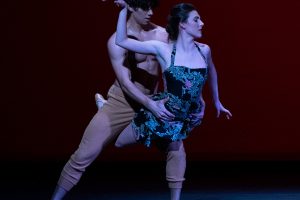

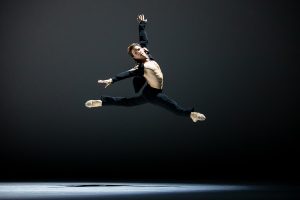



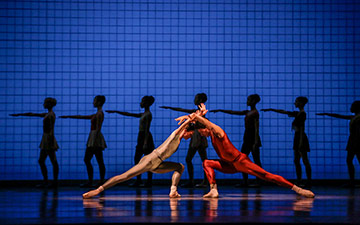
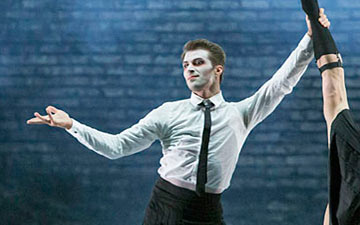

You must be logged in to post a comment.